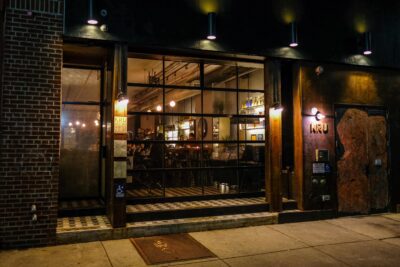Young Justice: Inside the Red Hook Youth Court
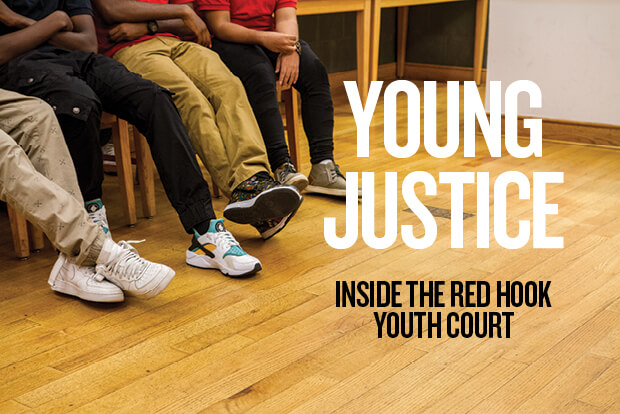

all photos by Jane Bruce
Early in October, a young man named Kellon sat in a heavy wooden chair inside the deliberation room at the Red Hook Community Justice Center. He wore a black polo shirt, had perfect posture, and made direct eye contact. From the hallway, enthusiastic voices leaked into the room and competed with his low baritone.
“Can we shut the door?”
Asking me was a courtesy. Kellon was already up, decisively shutting out the noise behind him.
“Everyone in my family is in law enforcement,” Kellon continues. “My father is a policeman, his father was a policeman, his father was a general. But my father’s son is now a lawyer.”
“I’m talking about myself,” Kellon clarifies. “I’m the lawyer.”
At 16-years-old, despite what he says, Kellon is not really a lawyer. Rather, he is a junior at the Urban Assembly School for Law and Justice in Downtown Brooklyn. But Kellon is not a liar, either. Every Tuesday and Thursday for the past two years—along with 15 other high school students—Kellon goes to the Red Hook Community Justice Center and serves as a member of its Youth Court.
Red Hook Youth Court is one of five operating Youth Courts in the city; other locations are in Queens, Staten Island, Harlem, Brownsville, and Newark. Youth Courts in New York operate in partnership with Community Justice Centers, like the one in Red Hook. (Many Youth Courts have popped up across the country in the past decade, though the one in Red Hook was both the city’s and one of the country’s first.) The overall directive of Community Justice Centers, which are supported by private and public partnerships, is to provide more effective and humane alternatives to detention, whenever possible. The Justice Center in Red Hook opened in June 2000, though the Youth Court had been established two years before that.
Rather than herding young people into an overcrowded and frequently immoderately punitive system, Youth Court members deliver rehabilitative sanctions to teens for misdemeanors in an effort to nudge them back on track early on, before things have a chance to get really bad. Most often sanctions take the form of community service, apology letters, job training, or anger management classes. Empathetic, early intervention—from peers, rather than authority figures—it’s believed, gives the youth respondents an unprecedented opportunity to be a real life hero in their own Choose Your Own Adventure story. Making a course adjustment at a critical juncture can bring about a dramatically different ending.
On a given evening, Youth Court members will conduct between one to three juried cases of peers who have committed misdemeanors—truancy, fare evasion, possession of marijuana or a low-grade weapon, trespassing, fighting—non-indictable offenses that have been referred to the Youth Court by the New York City Probation Department, Brooklyn Law Department, and local police precincts and schools.
Truancy hearings are most common (“every kid in Sunset Park is late,” Kellon jokes) and on the afternoon I visited, this was also the case. Kellon acted as the youth advocate, or defense lawyer, for the respondent. “If it’s truancy, we need to know why they were truant. The reason behind it. The subtext,” explains Kellon. “Basically, you get to know the person before you judge them.”
A few minutes later, Kellon took his place beside his youth respondent, a 17-year-old girl who had been caught skipping school in March. The bailiff, another youth member, led the courtroom in an oath of secrecy. The community advocate, or prosecutor, asked the jury to consider the harm done to the community and to the respondent herself by her actions. Kellon made his opening statement. “Please remember that a mistake does not define a person,” he says. The bailiff led the girl to the witness stand and asks if she promises to tell the truth. “Yeah,” says the girl. It was furtive. “Say, ‘yes,’” the young bailiff requests flatly, in response.
In unison, the 10 Youth Court jury members turned to face their peer. The lead juror opened with a line shared at the start of every hearing, composed by a former member. “We want you to know,” says the 15-year-old juror, “We’re here to help you, not judge you.”
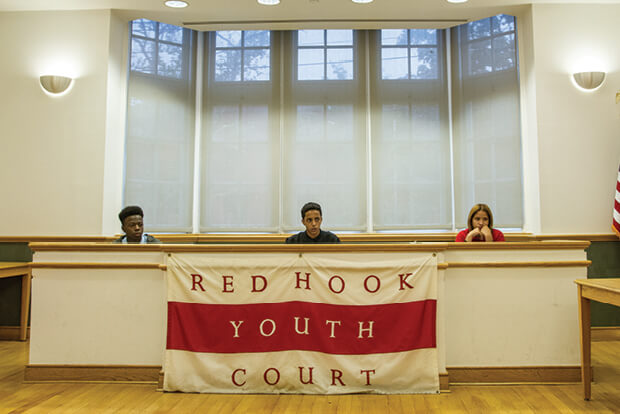

Community Justice Centers are one of many operating programs initiated by the Center for Court Innovation, located on 18th Street in Manhattan. In addition to community courts, the Center operates mediation programs, mental health and infant courts, and conducts research to create more effective systems for keeping offenders out of a criminal justice system that has long operated more like a non-rehabilitative black hole than an effective form of punishment.
Justice Centers, like the one in Red Hook, also serve adults who have committed real crimes. Judge Alex Calabrese has presided over every single case in the Justice Center’s criminal and family court since its first day of operation. In that time, he has reduced the number of adult offenders that have gone to jail by 35 percent. Rehabilitative programs are offered in place of detention in every possible instance. And, in the process, taxpayers save five thousand dollars per defendant compared to the cost of processing the same case in regular criminal court. In cases of recidivism, after offenders have been given generous second chances, Judge Calabrese will often send them to jail for twice as long.
The Director of the Community Justice Centers and Youth Courts in Red Hook and Brownsville is James Brodick. After graduating from college in 1995, Brodick planned to go to law school and began working for Victim Services, an AmeriCorps program in Red Hook, which, at the time, was in dire condition. “For a long time, Red Hook was a forgotten neighborhood and the crack epidemic hit it extremely hard,” said Brodick. In 1992, a local elementary school principal, Patrick Daly, was murdered, after getting caught in cross fire in public housing walking a sick student home from school. “The shooting was an enough-is-enough moment,” says Brodick. There was a new collective urgency to turning Red Hook around.
“There were partnerships with the Brooklyn DA’s office and Victim Services and the Center for Justice [in Midtown, the country’s first Community Justice Center, created to address low-level crimes around Times Square] to really think smarter about when people are touching the system, and how you stop crimes in the first place,” says Brodick. “One of the first things we wanted to do was train youth to hear cases and to build confidence in something that was not buying [the Red Hook community’s] trust. If you don’t get people when they make their first misstep, they don’t get back on track.”
Brodick became further steeped in the Red Hook community, training as a mediator, working for another AmeriCorps program, Public Safety Corps, and helping to start the Community Justice Center and Youth Court. For the AmeriCorps programs especially, Brodick said they were purposeful about working with local residents, as opposed to outsiders who would come to do the work, then leave. The work changed Brodick’s trajectory: He never went to law school.
“What I love most about Red Hook is that in 1995, when I got here, there were 12,000 people living there and 8,000-9,000 in public housing. Now, 20 years later, there are still 12,000 living here and 8,000-9,000 in public housing, but there has also been a shift where people started to believe: ‘I don’t have to take these conditions anymore,’” says Brodick. In other words, the demographics in Red Hook today are remarkably similar to two decades ago—despite the economic impact of places like Fairway Market and Ikea, as well as gentrification, which, while not as extreme as in other Brooklyn neighborhoods, is still a huge factor—because of a feeling cultivated from within the community that people were working toward something together.
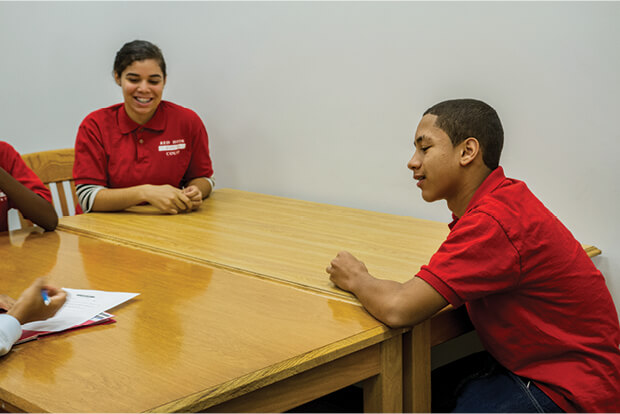

Today Brodick spends most of his time in Brownsville navigating local politics in an attempt to finalize a location for a Youth Court building (though an operating Youth Court program already serves 400-500 kids per year). The project has approval from all but one City Council Member, Darlene Mealy, who is not commenting on the matter.
“Red Hook in 1995 is Brownsville now,” says Brodick. “Fifteen years down the road, Brownsville will be another Red Hook.”
Back in the Youth Court, jurors began learning more about the girl who had skipped school. Their approach was impressive—for anybody, not just teenagers. No one spoke over anyone else; everyone interjected questions in turn, though there was no formalized system for doing so, then asked incisive follow-up questions. It appeared to be a team of professionals using a script-—but there wasn’t one, just an abundance of teamwork.
The lead juror on this case is Derece, a 15-year-old girl, petite and brimming with a kinetic energy that she ably keeps under control. Her goal is to become a senior Youth Court member one day, like Kellon. During questioning, her demeanor would pass muster at a military training camp, but that’s because Derece has worked hard to keep her proclivity to laugh in check.
“It’s hard not to laugh at some of the people in the cases,” says Derece, who sits with her friend Whitney, another Youth Court member. Both are students at the Secondary School of Journalism. “At first, me and Whitney, we’d burst out laughing.”
“I control myself,” interjects Whitney. “You just gotta realize what we’re doing, where we’re at, and that this is a serious thing.”
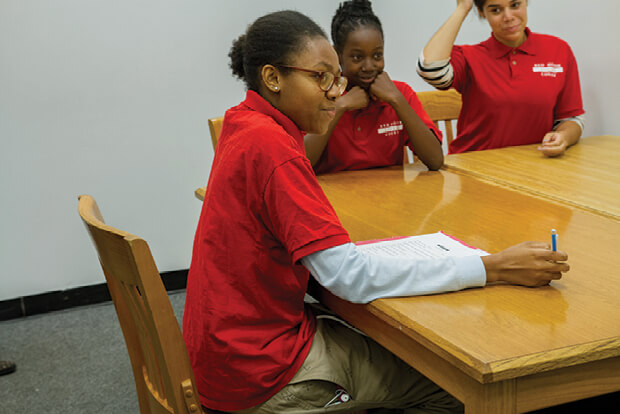

So, for example, when the youth respondent is 2-feet taller than her community advocate, it’s nearly impossible not to snicker, but all of them, save for rare exceptions, have learned to suppress the impulse. If they’re not serious, after all, the defendant definitely will not be.
The jury works its way through a line of questioning that fills out a more nuanced picture of the teen’s life. Their communication was nonverbal at times—they all seemed to know in unison when they’d learned enough information to reach a conclusion. There was a quiet efficiency which, when it comes to group decision making, is rare at any age, and certainly among kids.
After the presiding youth judge confirmed that there were no further questions, he dismissed the jury to discuss the case.
Sabrina Carter, Coordinator of Youth and Community Programs at the Red Hook Community Justice Center, grew up in the neighborhood and is a past Youth Court member. She began her job as program coordinator in Red Hook four years ago, when she was 24.
Carter was in kindergarten in 1992 when Principal Daly was murdered, and her mother was strict about keeping tabs on her whereabouts. “My mom was single and wanted to make sure we were not getting into any trouble,” says Carter. “I did every Youth Court program. They never made me feel like I couldn’t come back.”
The Youth Court program today is true to its original version, save for minor differences. For example, it now addresses issues that might not have been considered a crime when Sabrina was in kindergarten, like a fight in school. Then, it would have been half-addressed by school administrators and likely lead to repeat offenses; now, Youth Court gets those cases. The kids learn accountability for their actions but, more importantly, are made to understand they are not bad people—they just need help. And the peers who give it to them are oftentimes more similar to the respondents than not.
“We don’t always want the A students. We want students who are struggling too,” says Carter. “We’ve had former Youth Court respondents who have [later] joined and become members.”
Carter remembers one respondent-cum-member in particular, who she describes as irascible, a girl who wanted to fight everyone. Today this young woman attends LaGuardia Community College. Carter says, “Her parents were like, ‘What did you do to my daughter? She’s so different. She’s doing so well.’”
Carter says that one year, of the seven graduating Youth Court members, all were accepted to universities, and one got a full ride to Yale.
“Those are the stories that really shine to me and make me happy, because it’s just this little program, and I think the way we run it, we build relationships with kids,” says Carter. “They know there is a time to work and a time to play. This is what I didn’t know I wanted to do, but now I wouldn’t want to do anything else.”
In the deliberation room, the jurors sat down to review the facts in the case of the girl who skipped school. She usually wakes up late, they remember. This isn’t her first interaction with police. She doesn’t see herself as a role model, though she has two siblings. She doesn’t know how her actions will affect her goal of becoming a veterinarian, or how they affect the community.
“We should help her get a job,” says one member. From a list of available sanctions, they determine, with minimal dissent, that the respondent should take a skills-building workshop called Bridges to Employment, and another class called Motivating 101.
A juror sits down to write the verdict, composing out loud their collective decision. “We the jury give you [the respondent] the sanctions of…” but he is interrupted by another member.
“Don’t say sanctions, just say Motivating 101 and Bridges to Employment.”
“Ok, so, we the jury give you [the respondent] Motivating 101 and Bridges to Employment because, as stated, you would take the opportunity to get employed…”
“Don’t say ‘get employed,’” interjects another. “We’re not giving her a job, we’re helping her get a job.”
“We the jury give you [the respondent],” he writes the final version, “Motivating 101 and Bridges to Employment because, as stated, you would take the opportunity to help get employed, and we would like to encourage you in taking the steps to achieve your future goal.”
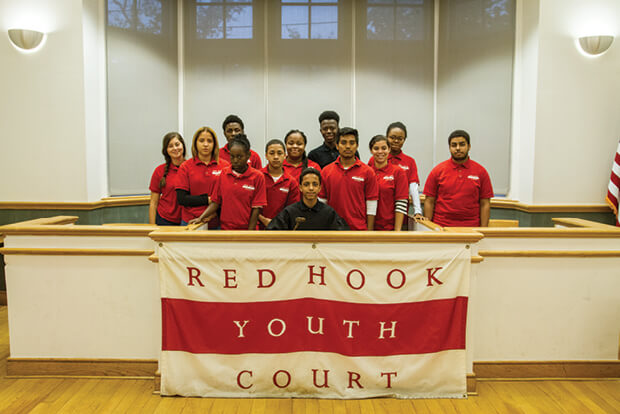

The jury members file back into the courtroom. The juror reads the team’s decision to the respondent, who stands next to her Youth Advocate, Kellon. The judge asks if she understands her sanction, to which she offers a quick response: “Yes.”
Before the hearing began, Kellon told me, “That’s what I don’t like about regular court—you stay in a cell for, what, one year, which could lead to the rest of your life, just thinking, ‘Damn, I really messed up.’”
Youth Court, on the other hand, is restorative justice. “Any criminal court, their purpose is only to obtain, seize, or subject,” says Kellon. “They never restore; they never help. I think that’s why I love it here. I help people.”
Almost as an afterthought, he adds, “Although prosecutors make way more money than defending attorneys, I like helping people.”
You might also like 














